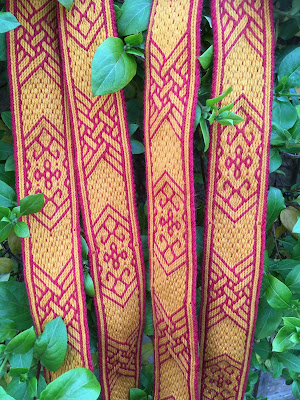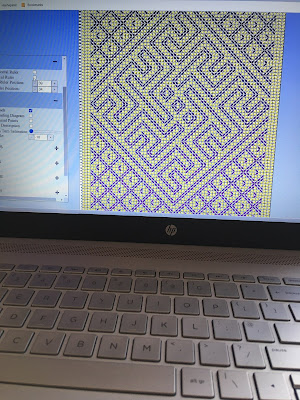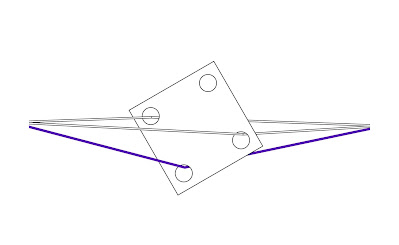I'm weaving a vacant-hole band at the moment and I've made a video about how I stop the tablets from rearranging themselves when they have one or more vacant holes. If you're having trouble weaving Petre from elsewhere on my blog, this should hopefully help.
Translate
Saturday, 3 July 2021
Branches
Sometimes people ask how I come up with my ideas. It varies quite a bit, depending on the project I'm working on. For my books Warp-Twined Angles and Vacant-Hole Pinwheels, when I was coming up with their large number of motifs, I worked out some of them by just playing around with a pencil and some draft paper and some of those lead on to others (what happens if I put this line here instead?). Further motifs came about when I was inputting the motifs into Tablet Weaving Draft Designer when I was inspired by the shapes the lines took on above where I was working.
The idea for this particular draft came to me when my mind was wandering during a Very Large Headache. I'd been thinking about coming up with a branching leaves type motif for a while. Sometimes I have an idea of the type of motif I want to weave, then my brain works away at it until it's ready to draw as a pencil sketch. This can be pretty unhelpful if the draft comes together in my head while I'm attempting to fall asleep!
I made a video of how I generated the draft for this band using TDD that you can view below.
You'll get a build up of twist behind some of the tablets for this draft, so you could tackle it using fishing swivels or combing it out manually, as I did. If you'd prefer to weave it out (working a version of the draft with turning directions opposite to what you've previously done), I've put together a reverse draft. Before you begin it, make sure that you've completely finish the last repetition of the draft above and that all the tablets are in the A-D position.
You can download the Branches reverse TDD draft by clicking here.
As with all of the free drafts on this site, you are welcome to weave them, sell bands woven using them, and use them to teach other weavers, just as long as you state where you found them.
Tuesday, 22 June 2021
New Video!
I have a new video up on my YouTube channel. In it I show you how I flip a tablet to change its threading direction.
Monday, 7 June 2021
Birka Band B22
When I was a beginner, all the way back in 2006, the very first band I tried to weave was based on one of the finds from a Viking cemetery in Birka, Sweden, dated to the 8th to 10th century. It's a lovely draft, but for me it was a tale of disaster from start to finish. I made pretty much every mistake there is and very nearly gave up on the whole thing. Several days later, I warped eight tablets for a simple four turns forward, four turns backward band and the rest is history. I'm not saying that you shouldn't try it as a beginner, but it would be helpful to have some muscle memory for turning the tablets before you tackle it.
I've been thinking about the draft again recently, as it turns up on Instagram pretty often, and I thought it would be fun to go back to the original source and take a look at the find that it's based on. Historiska Museet, Sweden, have kindly made many of the reports about the Birka digs available online as free pdf downloads. The textile finds are covered in Birka III - Die Textilfunde Aus den Grabern[1], with chapter VII "Bänder: Ein broschiertes Band — ein echtes Gewebe" (from page 75 onwards) discussing the tablet woven bands. The reports are in German, but copying and pasting sections into Google translate will produce something somewhat comprehensible.
The Carolyn Priest-Dorman draft[2] is based on a section from band B22, a label that Geijer uses for several similar finds, from graves 731, 750 and 824. The fragments from graves 731 and 750 were poorly preserved, but showed use of both gold and silver brocade wefts, like the better preserved example from grave 824 (detailed notes for the three bands are given on page 88 of Birka III - Die Textilfunde Aus den Grabern). Geijer describes the B22 band from grave 824 as having been woven with at least 29 tablets, with borders that needed a probable 6 tablets on each side (only the threads from 4 tablets on each side actually survive). The tablets were all threaded in the same direction and there were no turning reversals visible on the back of the band. She theorises that as the back of the band appears roughly woven and is rather unattractive, the band would originally have been sewn onto another fabric, leaving only the brocaded side visible. The band itself is 1.2cm wide and 9.5cm long and has around 20-25 brocade wefts per cm, with the gold weft at a greater density that the silver weft, perhaps because the gold was softer and easier to beat into place than the silver.
A schematic diagram of the motifs from the B22 band. Image from Geijer (1938) Birka III - Die Textilfunde Aus den Grabern Figure 20, page 83. I believe that the smaller section at the bottom is what Carolyn Priest-Dorman based her draft on. I chose to base my draft on the longer of the two sections
I freely admit that I don't enjoy weaving brocade, so I converted the motifs into 3x1 diagonals instead when I designed my version of the B22 find. I chose a yellow background colour to mimic the areas of the original that were covered by the gold brocade weft and "stave" borders for the selvedges, which are a fairly common feature of such bands[3]. I used red as my motif line and weft colour, as I liked the contrast between it and the yellow and the little spots of the red weft that show through in the large yellow sections mimic the brocade weft tie-down points of the original. I also chose to weave it in King Cole Merino Blend 4-ply (in mustard and scarlet) instead of the silk[4] of the original, as that was what I had to hand in the colours I wanted. This means that my band is 4.3cm wide, rather than the original 1.2cm.
I have designed the band to be twist-neutral for the pattern tablets (you will get a build-up of twist behind the four selvedge tablets on each side of the draft), so the pattern repeat is pretty long to incorporate a lattice section that twines in the opposite direction. I've split the draft itself into two pieces to make them easier to work from, in such a way that you can weave from just one of them without breaking the motifs, if you prefer. You can view them at their full size by clicking on the draft to select it, then right-clicking on it and selecting "open image in new tab", click on it one more time in the new tab and it should be much bigger.
You can download the TDD file for this draft by clicking here.
As the turning diagram for this draft is over 200 picks long, I've chosen not to include the text description in this post. Instead, you can download it by clicking here.
References
[1] Geijer, Agnes (1938). Birka III - Die Textilfunde Aus den Grabern. Birka: Untersuchungen und Studien III. Uppsala: Almkvist and Wiksells B.A., Kungl. Vitterhets Antikvitets Akadamien. Retrieved from: https://historiska.se/digitala-resurser/filer/pdf/Birka_III.pdf (17/05/2021)
[2] Priest-Dorman, C. (1993). Viking-Style Tablet Weaving: Birka Strapwork Motif, Retrieved from: https://www.cs.vassar.edu/~capriest/birkarcp.html (17/05/2021)
[3] Spies, N. (2000). Ecclesiastical Pomp and Aristocratic Circumstance: A Thousand Years Of Brocaded Tabletwoven Bands, Arelate Studio
[4] Ostrom Peters, C. (2002). The Silk Road Textiles at Birka: An Examination of the Tabletwoven Bands, The Textile Society of America Symposium Proceedings, Retrieved from: https://digitalcommons.unl.edu/cgi/viewcontent.cgi?referer=https://www.google.com/&httpsredir=1&article=1407&context=tsaconf (17/05/2021)
Sunday, 6 June 2021
New Video!
I have a new video up on YouTube. It's all about how I use TDD to generate narrow drafts from tablet weaving. I'll be sharing the draft on my blog for free, just as soon as I finish the sample band.
Friday, 4 June 2021
The New Warp-Twined Angles is Ready!
I'm really excited to share the new Tablet Weaving in Theory and Practice: Warp-Twined Angles books with you!
Over the past three months, I've been working on a new (old?) project and it's ready to share! In fact, it went live in the Blurb online book shop on the 1st of June.
Tablet Weaving in Theory and Practice: Warp-Twined Angles Volume One
The 42 drafts from the first edition of Warp-Twined Angles, reformatted to make them easier to use, with all new samples and photography.
Tablet Weaving in Theory and Practice: Warp-Twined Angles Volume Two
65 new drafts in the same style as the first edition, published separately for people who have the first edition and just want the new drafts.
Tablet Weaving in Theory and Practice: Warp-Twined Angles Combined Edition
All 107 drafts collected together in a single volume. There's no material in the Combined Edition that doesn't also appear in the separate volumes and vice versa.
Tuesday, 11 May 2021
My Design Process for Large Drafts
Step 1
Step 2
Step 4
Step 5
Step 6
Friday, 7 May 2021
Exciting Book News!
Wednesday, 7 April 2021
Petre
This draft is based on a German brick-stitch pattern from the Hildesheim Cope (accession number: 17-1873), specifically the section that deals with the martyring of Saint Peter (spelled "Petre" in Latin). I've been fascinated by the Cope since I first saw it in the summer of 2016, on display in Medieval and Renaissance Room 9 at the Victoria and Albert Museum in London. It's a large embroidered semi-circular vestment, dated to the 12th century, adorned by a number of tablet woven brocaded bands. I discuss the motifs of these bands in more detail in my book Tablet Weaving in Theory and Practice: Vacant-Hole Pinwheels.
I decided to design this draft as vacant-hole (one or more holes of the tablets are left intentionally empty), but to set up the tablet threading so that all the tablets would turn together in the same direction to make a quick and simple weave. This makes it an excellent first band if you've never tried the technique before.
When I was weaving the sample, I flipped the threading direction of the selvedge tablets (tablets 1, 2, 3, 36, 37 and 38) so that I could turn them together with the pattern tablets. When you flip a tablet, then turn it in the opposite direction, its threads will continue to twine in the same way as before. A Z-threaded turned backwards will produce the same result as an S-threaded tablet turned forwards.
If you take a break during weaving this draft, be sure to secure the tablets with an elastic band or by tying a cord around them (or what ever method you prefer) as they may re-orient themselves so that the vacant-hole is either at the top or bottom of the pack.
The vacant holes of the tablets are represented by empty squares in the draft below and by the word "Empty" in the text version of the draft. The sample was woven using a white weft, flecks of which can be seen on the surface of the band, where they would normally have been covered if the vacant holes of the tablets were filled. If you'd prefer, the draft's turning sequence will be the same if the vacant holes of the tablets are filled. If you do this, I suggest picking a thread that is the same as your background colour and using a weft that's the same colour as the lines for your motifs.
You can download the TDD file for this draft by clicking here.
The text version of this draft is as follows:
- Threading:
- S threaded tablet
- White (#ffffff)
- White (#ffffff)
- White (#ffffff)
- White (#ffffff)
- Z threaded tablet
- Red (#ff0000)
- Red (#ff0000)
- Red (#ff0000)
- Red (#ff0000)
- S threaded tablet
- White (#ffffff)
- White (#ffffff)
- White (#ffffff)
- White (#ffffff)
- Z threaded tablet
- Red (#ff0000)
- White (#ffffff)
- Empty
- White (#ffffff)
- Z threaded tablet
- White (#ffffff)
- Red (#ff0000)
- White (#ffffff)
- Empty
- Z threaded tablet
- Empty
- White (#ffffff)
- Red (#ff0000)
- White (#ffffff)
- Z threaded tablet
- White (#ffffff)
- Empty
- White (#ffffff)
- Red (#ff0000)
- S threaded tablet
- White (#ffffff)
- Empty
- White (#ffffff)
- Red (#ff0000)
- S threaded tablet
- Empty
- White (#ffffff)
- Red (#ff0000)
- White (#ffffff)
- S threaded tablet
- White (#ffffff)
- Red (#ff0000)
- White (#ffffff)
- Empty
- S threaded tablet
- Red (#ff0000)
- White (#ffffff)
- Empty
- White (#ffffff)
- Z threaded tablet
- Red (#ff0000)
- White (#ffffff)
- Empty
- White (#ffffff)
- Z threaded tablet
- White (#ffffff)
- Red (#ff0000)
- White (#ffffff)
- Empty
- Z threaded tablet
- Empty
- White (#ffffff)
- Red (#ff0000)
- White (#ffffff)
- Z threaded tablet
- White (#ffffff)
- Empty
- White (#ffffff)
- Red (#ff0000)
- S threaded tablet
- White (#ffffff)
- Empty
- White (#ffffff)
- Red (#ff0000)
- S threaded tablet
- Empty
- White (#ffffff)
- Red (#ff0000)
- White (#ffffff)
- S threaded tablet
- White (#ffffff)
- Red (#ff0000)
- White (#ffffff)
- Empty
- S threaded tablet
- Red (#ff0000)
- White (#ffffff)
- Empty
- White (#ffffff)
- S threaded tablet
- White (#ffffff)
- Empty
- White (#ffffff)
- Red (#ff0000)
- S threaded tablet
- Empty
- White (#ffffff)
- Red (#ff0000)
- White (#ffffff)
- S threaded tablet
- White (#ffffff)
- Red (#ff0000)
- White (#ffffff)
- Empty
- S threaded tablet
- Red (#ff0000)
- White (#ffffff)
- Empty
- White (#ffffff)
- Z threaded tablet
- Red (#ff0000)
- White (#ffffff)
- Empty
- White (#ffffff)
- Z threaded tablet
- White (#ffffff)
- Red (#ff0000)
- White (#ffffff)
- Empty
- Z threaded tablet
- Empty
- White (#ffffff)
- Red (#ff0000)
- White (#ffffff)
- Z threaded tablet
- White (#ffffff)
- Empty
- White (#ffffff)
- Red (#ff0000)
- S threaded tablet
- White (#ffffff)
- Empty
- White (#ffffff)
- Red (#ff0000)
- S threaded tablet
- Empty
- White (#ffffff)
- Red (#ff0000)
- White (#ffffff)
- S threaded tablet
- White (#ffffff)
- Red (#ff0000)
- White (#ffffff)
- Empty
- S threaded tablet
- Red (#ff0000)
- White (#ffffff)
- Empty
- White (#ffffff)
- Z threaded tablet
- Red (#ff0000)
- White (#ffffff)
- Empty
- White (#ffffff)
- Z threaded tablet
- White (#ffffff)
- Red (#ff0000)
- White (#ffffff)
- Empty
- Z threaded tablet
- Empty
- White (#ffffff)
- Red (#ff0000)
- White (#ffffff)
- Z threaded tablet
- White (#ffffff)
- Empty
- White (#ffffff)
- Red (#ff0000)
- S threaded tablet
- White (#ffffff)
- White (#ffffff)
- White (#ffffff)
- White (#ffffff)
- Z threaded tablet
- Red (#ff0000)
- Red (#ff0000)
- Red (#ff0000)
- Red (#ff0000)
- S threaded tablet
- White (#ffffff)
- White (#ffffff)
- White (#ffffff)
- White (#ffffff)
- Turning:
- 38F
- 38F
- 38F
- 38F
- 3F 32B 3F
- 3F 32B 3F
- 3F 32B 3F
- 3F 32B 3F
- 38F
- 38F
- 38F
- 38F
- 3F 32B 3F
- 3F 32B 3F
- 3F 32B 3F
- 3F 32B 3F
- 3F 32B 3F
- 3F 32B 3F
- 3F 32B 3F
- 3F 32B 3F
- 38F
- 38F
- 38F
- 38F
- 3F 32B 3F
- 3F 32B 3F
- 3F 32B 3F
- 3F 32B 3F
- 38F
- 38F
- 38F
- 38F
Friday, 2 April 2021
Threading Errors Video



















